1110 Search Results for Core
June 5, 2013
by Robin Parker -
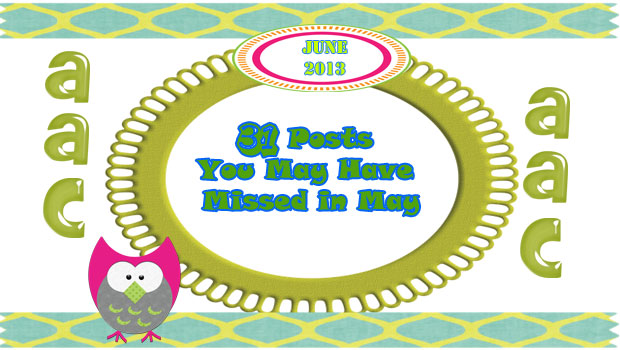
Strategy of The Month Communication Boards: Colorful Considerations Communication Boards Can Be Used For…. A Lot I Made A Communication Board: Bow What Join Together: Core & Fringe Vocabulary Fresh Look AAC in the Classroom with Joan Bruno Friendship Skills for Children Who Use AAC with Dr. Erinn Finke Top 5 Switches for People With ALS by Amy Roman AAC & Dementia with Dr. Melanie Fried Oken AAC for Children Who Have Rett Syndrome with Dr. Theresa Bartolotta AACtual TherapyHow We Do It Essential Tricks for Supporting AAC in Schools, Part 2 PrAACtical Look: AAC at Dynamic Therapy Associates by Vicki Clarke A Framework for Success Getting Started in the Exciting World of Communication & AAC with Marlene Cummings AAC Myth Buster Wrap-Up PrAActical Thinking It’s PrAACtically Better Hearing & Speech Month 30 Posts You May Have Missed for Autism Awareness Month It’s PrAACtically Mother’s Day- 5 Activities that Support... [Read More...]
June 4, 2013
by Carole Zangari -
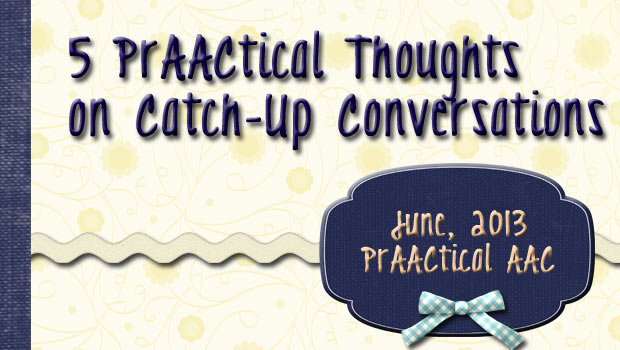
One of the things SLPs frequently do at the start of their therapy sessions is have some casual conversations with their clients to catch up on what happened since their last visit. Whether it is an elementary school student with ASD, a teenager with cerebral palsy, or an older adult with aphasia, we engage in polite conversation to find out what they’ve been up to and perhaps share a bit about our own experiences. Here are some thoughts on making those ‘catch-up conversations’ work from a prAACtical perspective. 1. Possible goal areas: initiate conversation; maintain dialogue on an established topic; redirect conversation to a new topic; respond to non-obligatory communication opportunities; use temporal terms in multi-word utterances; convey a personal narrative with a clear beginning, middle, and end; use regular past tense verbs; ask partner-focused questions 2. Core language targets: it, we, they, do/did, have/had, was/were, not It was (not);... [Read More...]
June 1, 2013
by Carole Zangari -
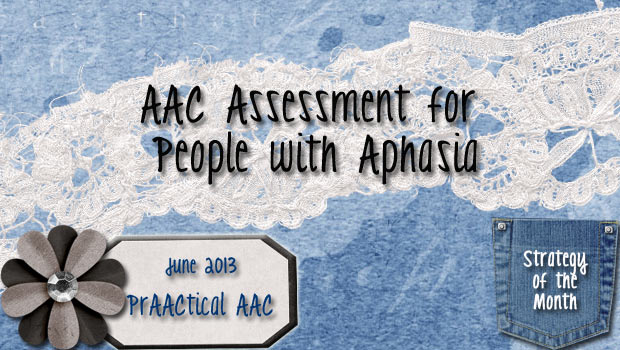
Many people with aphasia fail to regain sufficient speech and language skills to meet their communication needs. With more than one million people with aphasia in the US alone, chances are most people reading this know at least one person affected by the disorder. While many go on to regain functional speech and language skills, some remain unable to communicate well enough catch up with a neighbor, talk about bills with a spouse, ask a question in a store, play with a grandchild, or tell their healthcare providers about side effects or symptoms. It’s hard to really imagine how devastating and isolating this experience may be. Aphasia Awareness Month seemed like the perfect time to reach out to SLPs with information on AAC for people with aphasia. In this post, we’ll share some thoughts and resources on assessment. Assessment activities are, of course, driven by the purpose for which the... [Read More...]
May 30, 2013
by Carole Zangari -
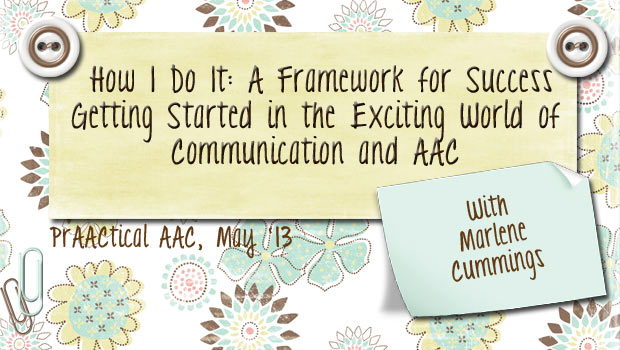
We couldn’t be more excited to have a return visit from Marlene Cummings, a wonderful SLP who is currently serving as an AAC Consultant to the AAC Team at Oakland Schools. In her first post, Marlene talked about strategies for cultivating the right mindset for AAC teaching. In this post, Marlene continues sharing elements of her Framework for Success in discussing the Knowledge Toolbox, developed with the Oakland Schools AAC Team. 5 Things in Your “Knowledge Toolbox” What is already in my “knowledge toolbox” of communication, language and learning? Yes, you do have a full toolbox. You just don’t realize it. And of course there are always new and exciting things to add. You already know this stuff!! REMEMBER??? It is important to step back and think broadly about communication and what it really does. Sometimes we get caught in the details of our work and can’t see the forest through the... [Read More...]
May 29, 2013
by Carole Zangari -
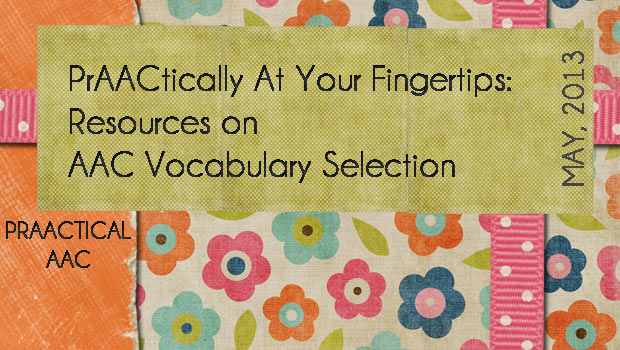
Need information on selecting vocabulary for someone with AAC needs? You can’t go wrong with Lauren Enders’ Pinterest board on this topic. She’s collected some wonderful posts, documents, and videos. Check it out here.
May 28, 2013
by Robin Parker -
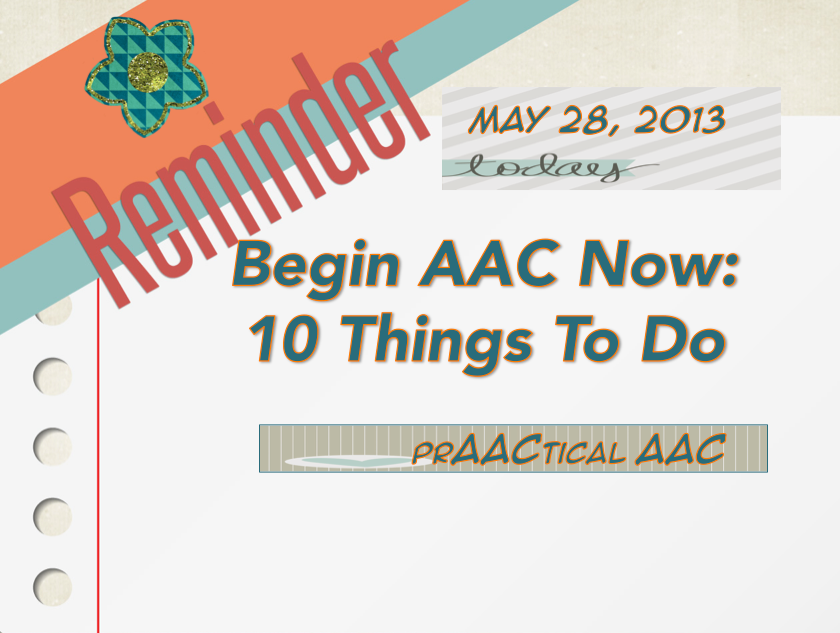
If you know someone with significant speech difficulties, BEGIN AAC NOW…. If you know someone, try something… Doing something, even if it isn’t perfect, is infinitely better than doing nothing at all…. There is no specific order for these suggestions, try what is appropriate and doable for you… A year from now you may wish you started today (K. Lamb)… So begin now at any level.. for someone, a class, a clinic, for a few… Create a Visual Language & AAC Environment: Visual Immersion Program, Meaningful Language Experiences, Importance of Using Visual Supports Speak AAC to the AAC Learner: Use Aided Language Input (ALI), Learning to Use ALI Get Assessment Information: Communication Matrix , AAC Evaluation Genie, Thoughts & Ideas, AAC Assessment Forms, Write & Implement Some AAC Goals: Goals That Matter, AAC in the IEP by Lauren Enders, PrAActical Goals Learn and Use a Core Word Approach: Core Word Communication Board Samples, About Core Words- First... [Read More...]
May 26, 2013
by Carole Zangari -
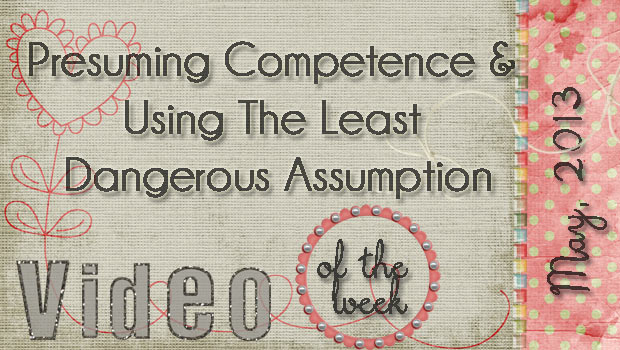
One of our core language posts from last month referred to the criterion of the least dangerous assumption (Donellan, 1984). This week we’re pleased to be able to expand on that topic and share a video by Dr. Cheryl Jorgensen, a former project director at the Institute on Disability at the University of New Hampshire. As we near the end of a school year in the US and begin IEPs that will direct the activities for the next academic year, we’re all reminded how critical it is to set high but attainable goals. Sometimes, that means making the least dangerous assumption. You can view the video here. Donnellan, A. (1984). The criterion of the least dangerous assumption. Behavior Disorders, 9, 2, 141-150.
May 18, 2013
by Carole Zangari -
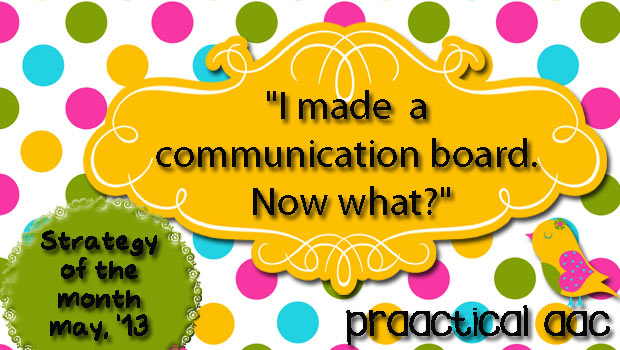
Earlier this month, we shared some ideas for making communication boards using color coding and also for creating boards geared to different communicative purposes. Making the communication board according to some basic principles is a good thing, of course, and it takes a decent amount of thought and planning. Even more important, though, is developing an intervention plan so that the augmentative communicator learns how to use the board effectively. Here are some of our thoughts on how to teach someone to use a new communication board. Model It We’ve talked about aided language input so many times that I’m almost embarrassed to mention it. Almost. The truth is, it is a ‘must do’ strategy when we’re first introducing a communication board, book, SGD, or AAC app. Incidental learning is important for just about all of the people with whom we work. It is never the only strategy we use,... [Read More...]
May 11, 2013
by Robin Parker -
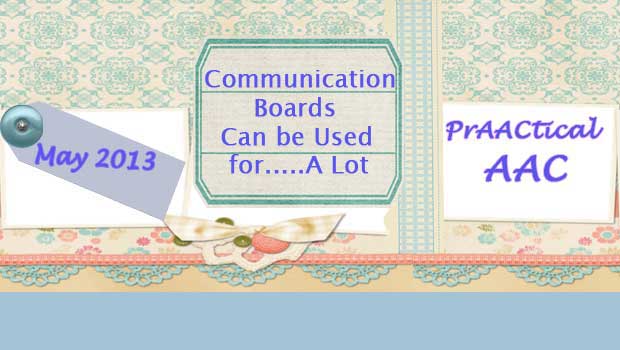
When we think of AAC and communication boards or displays, we often think of comprehensive core and fringe words. We think of a board that will represent the most possible communication functions, vocabulary, and generative language. However, there are many other ways to create and use communication boards. There are many other ways because there are many reasons we communicate and sometimes it is best to create a communication board that focuses on a specific communication need. AAC is not one thing but a system of communication supports, and for most AAC users, there should be a multitude of communication options that will aid in robust communication and language needs. All AAC users should have a comprehensive individual communication display whether low tech (communication book) or high-tech (AAC device or App). But…. many AAC users will also benefit from communication boards that support a specific communication purpose. The reason for... [Read More...]
May 7, 2013
by Carole Zangari -
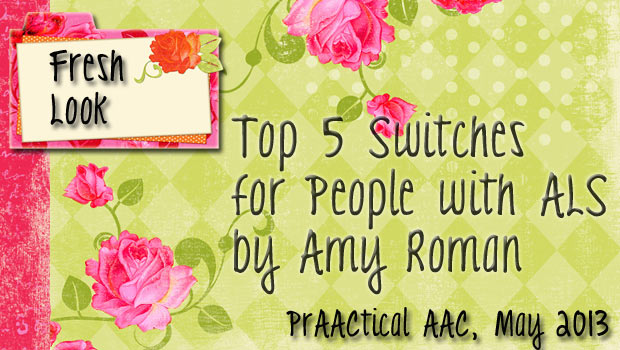
We continue our celebration of Better Hearing and Speech Month (#BHSM) with our Fresh Look series. In this post, we are delighted to share the insights of SLP Amy Roman, whose expertise in AAC supports for people with ALS is well-known. During the past 13 years, Amy has been a member of the multidisciplinary care team at San Francisco’s Forbes Norris ALS Research and Treatment Center. The AAC Program she developed at the Norris Center was awarded Program of the Year by the California Speech and Hearing Association in 2010. Through her private practice, she also provides AAC direct services and phone/skype consultations to individuals, caregivers and therapists. In addition, Amy is the Director of the Golden West ALS Association’s AAC Lending Library. She is also the author of AlphaCore© communication software available on DynaVox speech generating devices. Amy has presents workshops and at conferences on clinical and research topics in AAC.... [Read More...]









